Lifestyle
Extrema Ratio Dobermann IV African Review
Published
5 years agoon
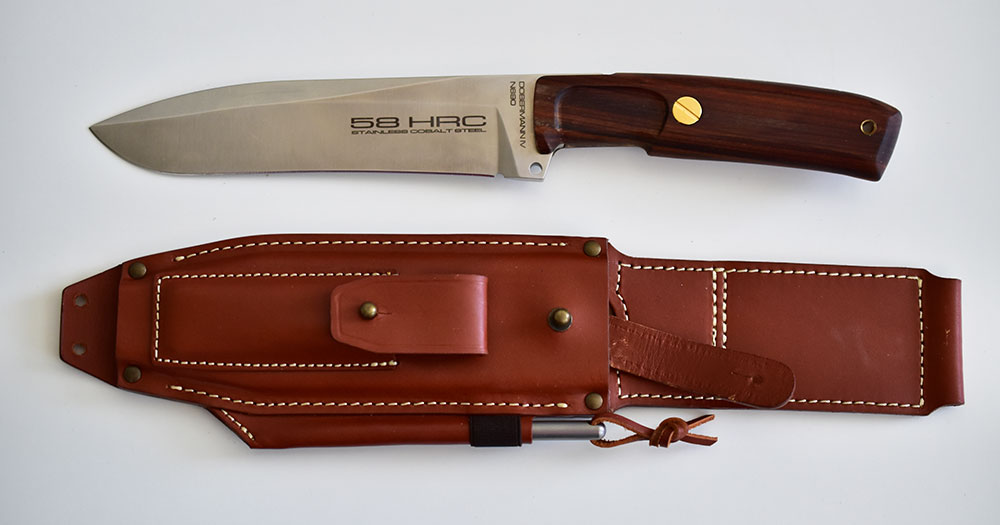
Those who have been in the wilderness know that the only thing you can depend on is your instincts and your knife. Anything that requires battery can and likely will fail. Even live ammunition can fail in a damp environment. Time and time again, your knife will be the one equipment you turn to. It’s the most essential gear for survival as its versatility serves both offensive and survival purposes.
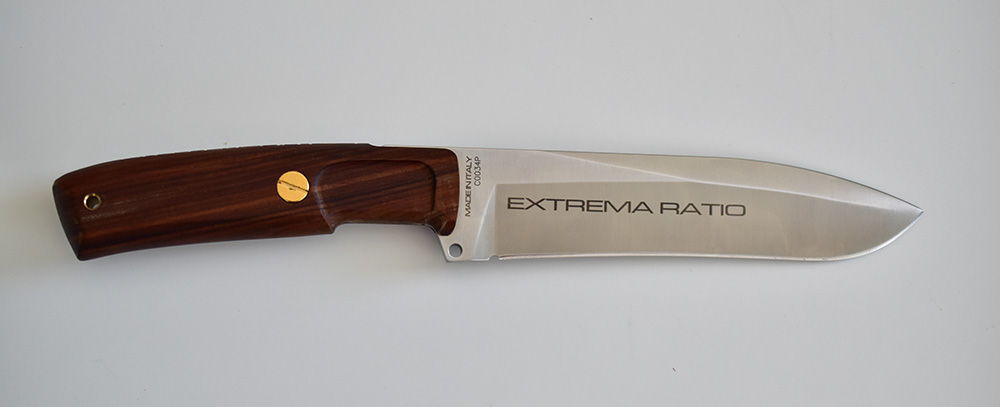
Extrema Ratio is known for making high-quality blades. Their website offers a wide selection of blades, however, the one that stands out most is the Dobermann IV Africa. The Dobermann IV Africa is a 7.3″ hunting made from Bohler N690 steel that promises to be your best friend on your next hunting trip – for $690 USD. In this review, we’re going to take a closer look at all the features of this blade and determine if it’s worth the price tag.
What’s in the package?
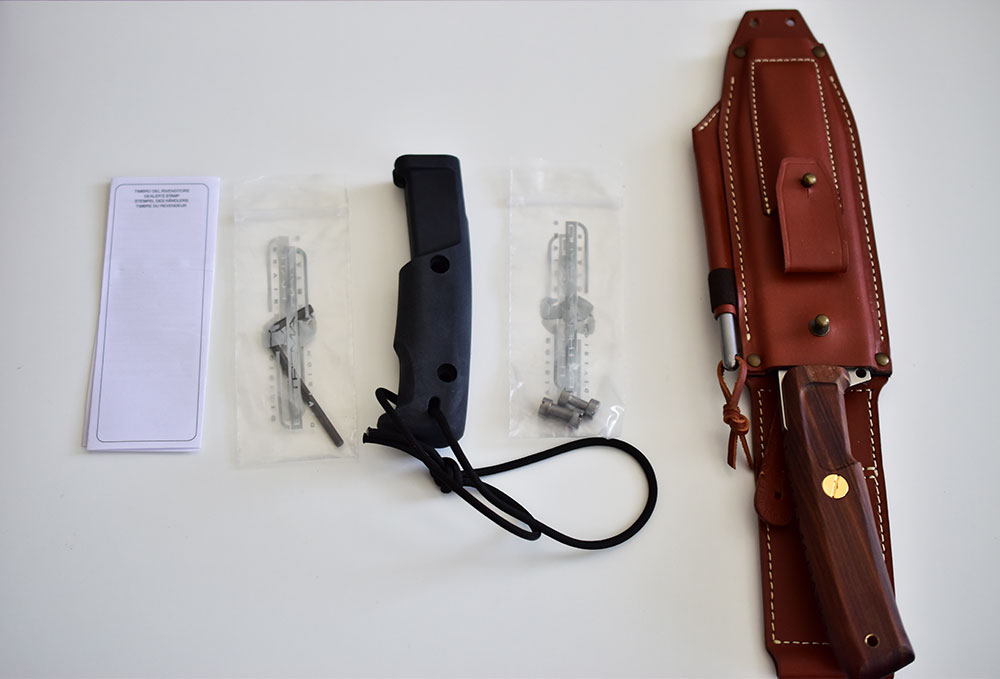
If you purchase the Dobermann directly from Extrema Ratio’s website, you’ll get a lot of extra accessories including a portable blade sharpener, a marlin spike, and an extra handle made from Forprene.
Extrema Ratio, being an Italian company, is generous with leather laces. Just about every single holes on the sheath came with a foot of laces. There’s easily 10 feet of laces included in the package. It’s a bit overkill, however, appreciated since the laces can be used for tying things down. The pictures above and below don’t show you how much laces are included. We had to trim most of it for photos.

The leather sheath is made from high-quality Italian leather (as you’d expect). There’s a stiffness to the leather that gives it extra durability and makes it resistant to scratches. The sheath has a hard plastic interior that houses the blade to ensure the blade doesn’t damage the sheath over repeated use. All the stitches you see are real.
Marlin Spike
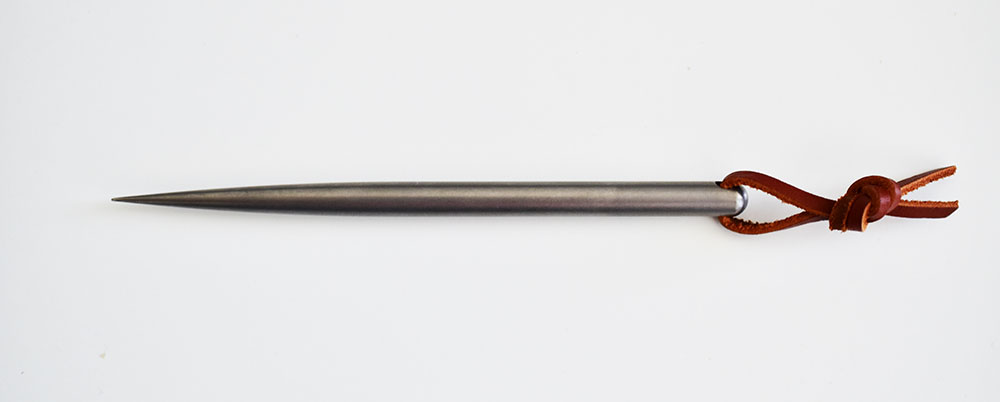
The Dobermann IV Africa comes with a marlinspike already in the package. The leather sheath has a special side pocket for the spike that holds it in place via an elastic belt. The spike seems to be made from the same N690 steel (not confirmed). It’s heavy, solidly constructed, and pointy.
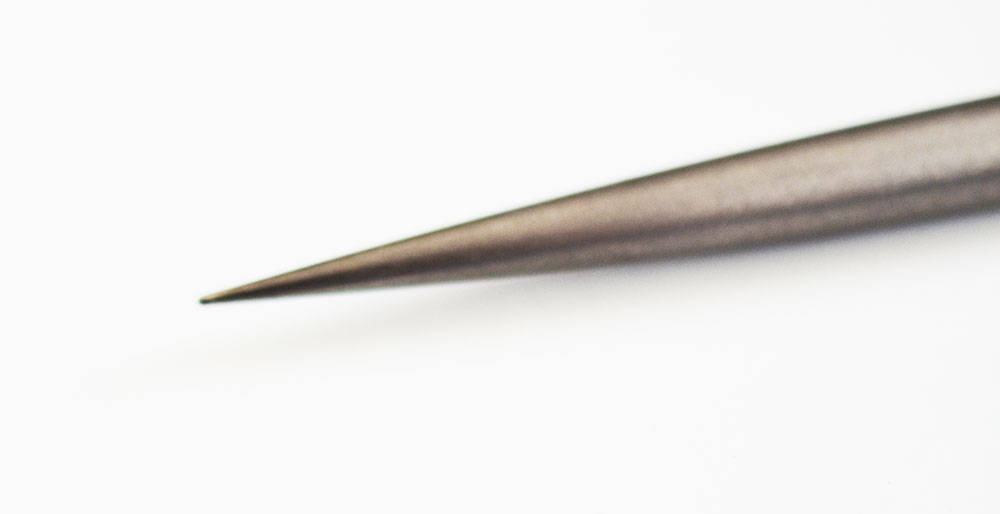
Given how pointy this spike is, experienced hunters can use this for more than tying and untying knots.
Blade Sharpener
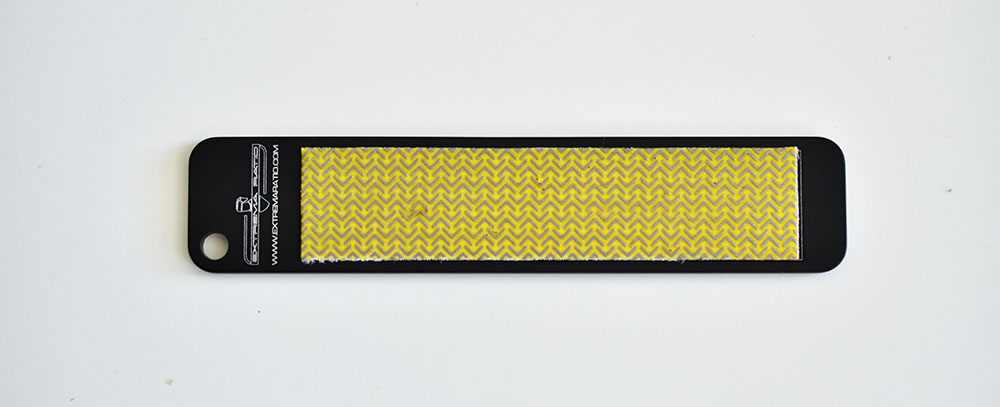
Also included in the package is a custom-made blade sharpener. Just like the marlinspike, there’s a special pocket on the sheath for this accessory. It’s a bit difficult to access and you may need to remove the blade in order to get it out. That’s not a major issue since you’re not going to be sharpening the blade that frequently given its HRC 58 hardness.
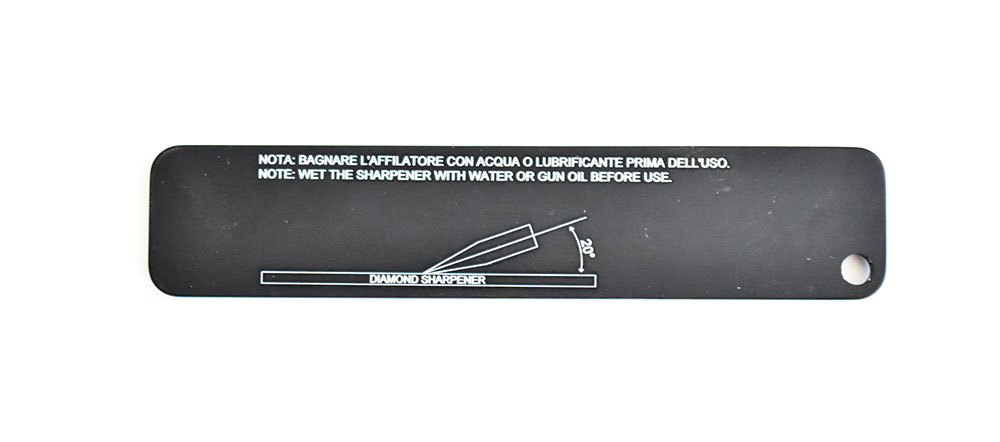
The back of the sharpener has laser-engraved instructions showing you how to sharpen your knife. It also has a carved out hole in case you want to carry this on a keychain or on your backpack.
Santos Rosewood Handle
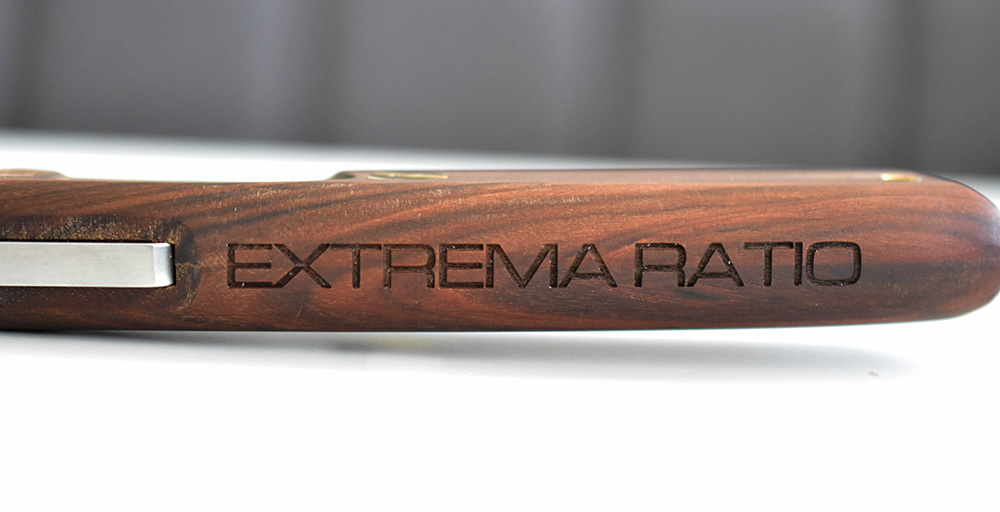
The Dobermann IV actually has two versions. The regular tactical version comes with the Forprene handle and black steel blade. The Africa version comes with Santos Rosewood handle, leather sheath, accessories, and a satin blade finish. Both versions are made from the same N690 steel.
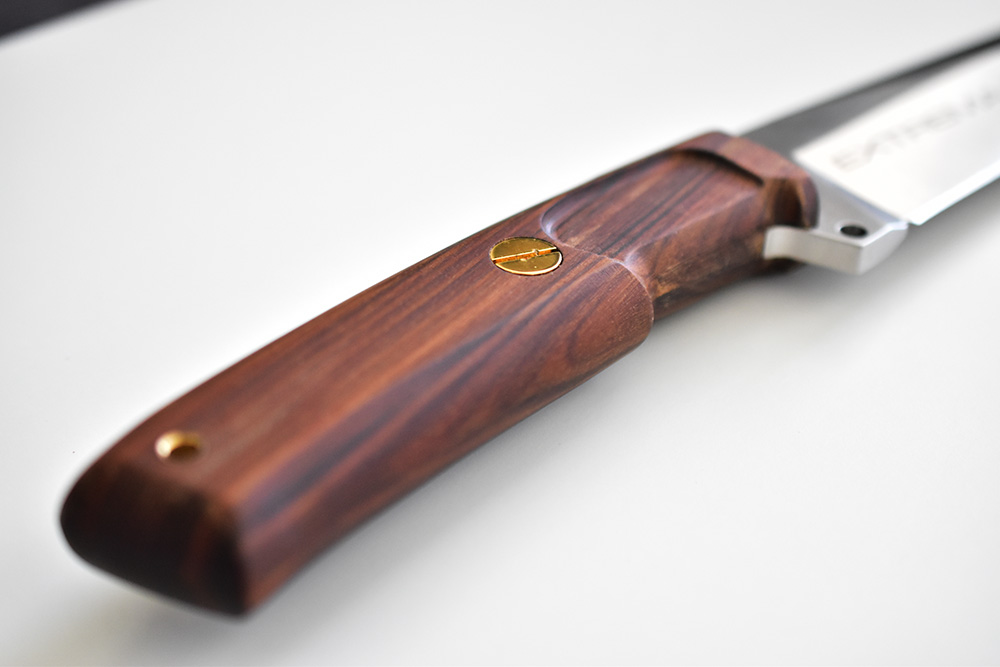
There’s an “Extrema Ratio” branding carved onto the spine of the handle, just in case you forgot who made your knife. The handle has the signature finger grip indentation that’s proprietary to Extreme Ratio knives. It’s a great design and feels good in your hand. The indentation for your index and middle finger adds both grip and control, making the blade easier to handle.
Rosewood vs Forprene
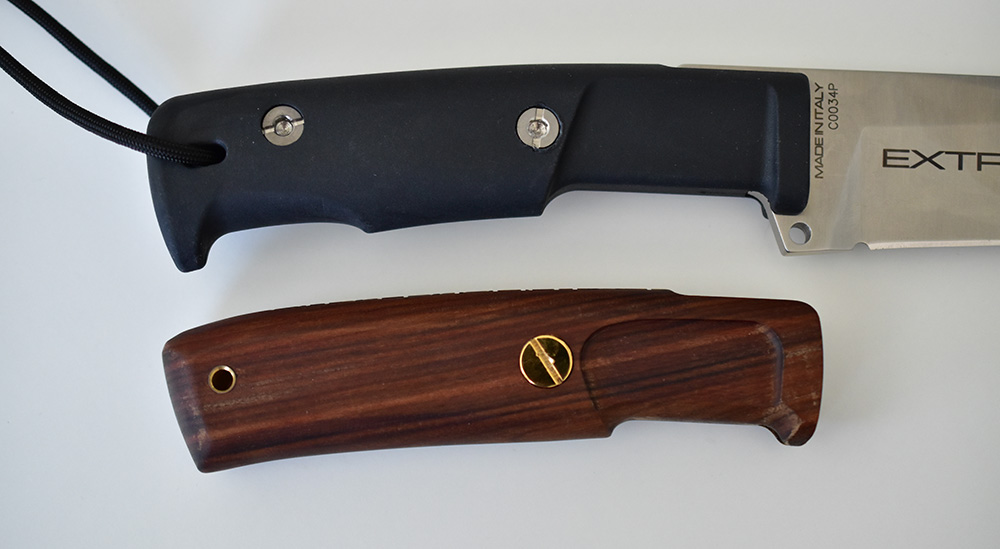
There’s something very interesting to note about the two handles. On the surface, it might look like the Santos Rosewood is just a wooden version of the original Forprene handle, but take a closer look. Take a look at the picture above and you’ll notice how different they look from each other. The Forprene has a different butt that seems to hand an indentation for pinky grip, meanwhile, the rosewood doesn’t.
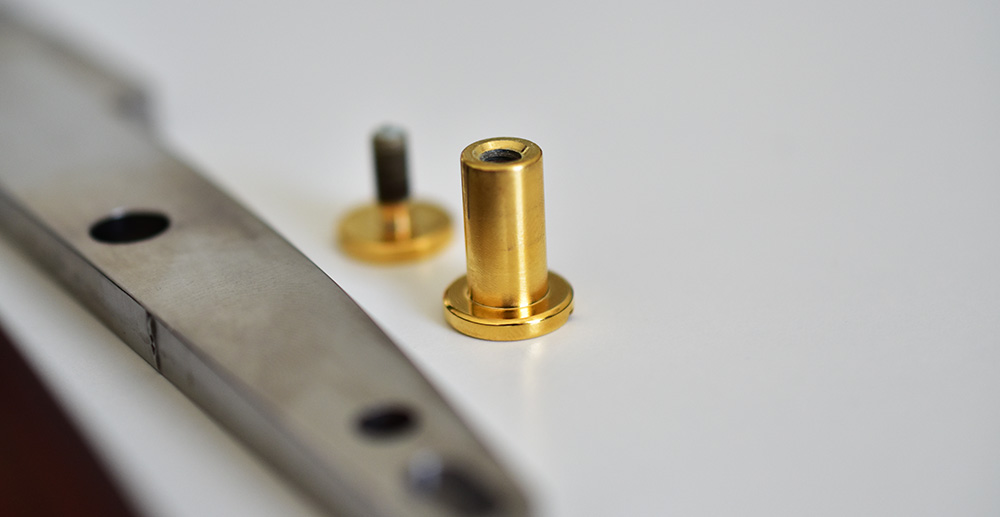
Extrema Ratio gives you two sets of screws to be used for each handle. The Rosewood handle uses just one set of gold screws. Meanwhile, the Forprene handle comes with two sets of stainless steel screws.
The dual screws on the Forprene handle actually feel more secure. Even if you wanted to use two screws on the Rosewood handle, you actually can’t, because the holes aren’t there. I’m not sure why the engineers at Extrema Ratio opted for a single-screw system on the wooden handle.
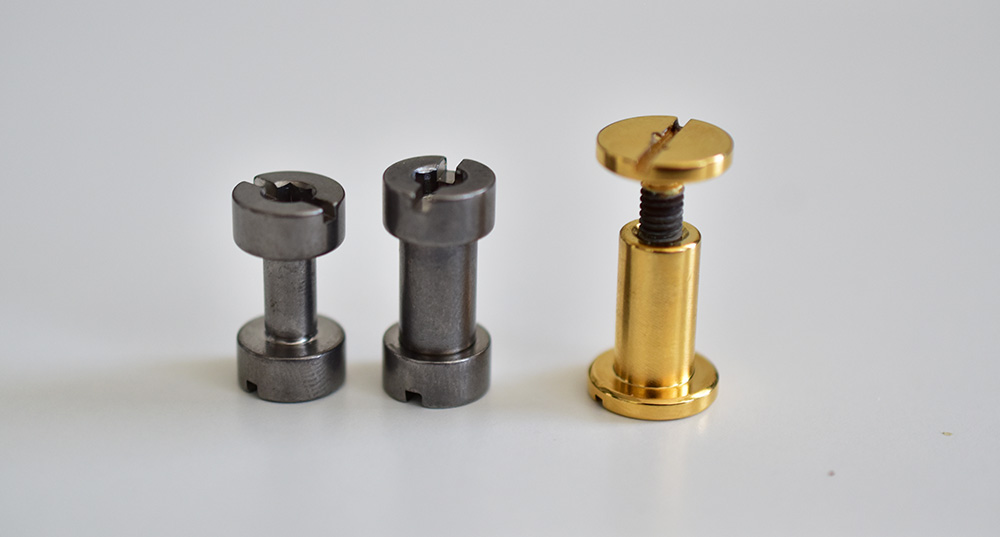
The screws are actually different in their construction. The Golden screws for the Rosewood handle feel like they’re made from aluminum. They’re lighter than the stainless steel screws used for the Forprene handles. The two stainless steel screws’ head is fitted for both a flathead screwdriver AND an Allen wrench. The golden screw can only be used with a flathead screwdriver, which is a slight inconvenience.
Although the golden screw looks gorgeous, I like the construction and flexibility of the stainless steel screws more.
3/4 Tang
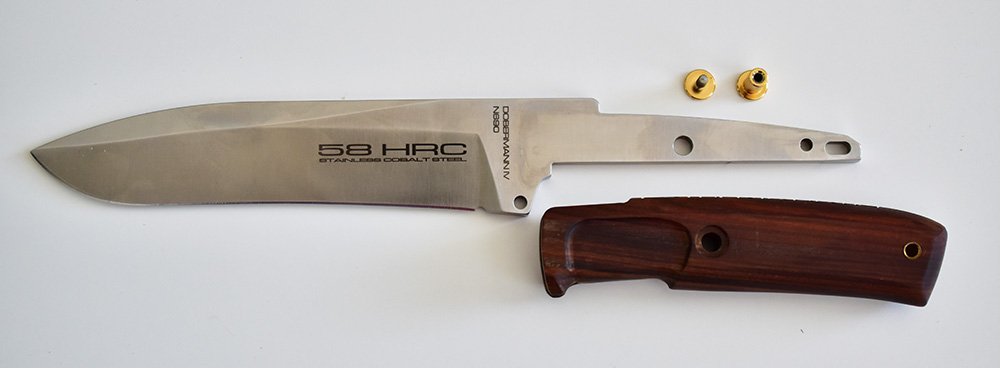
It’s also worth noting that the blade isn’t a full-tang. It’s about a 3/4 tang. The handle is plenty snug and once clamped down, it feels just as tight and balanced as a full-tang blade.
Both handles are one piece giving it extra snug. Assembling and unassembling the handle can be difficult while you’re outside since the handle holds the blade in place VERY securely.
The Blade
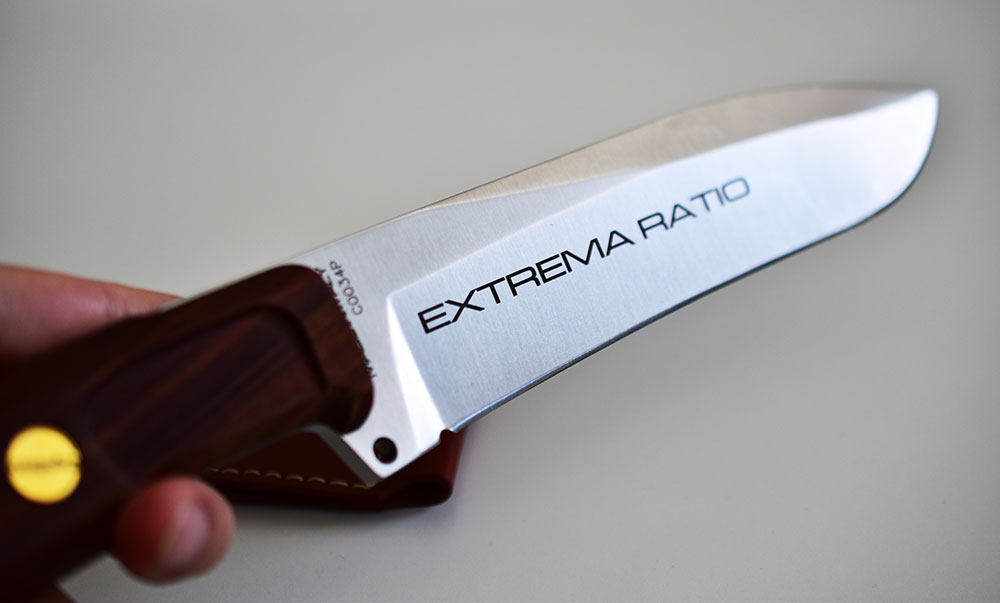
The knife is 13.3 inches long with a blade length of 7.3 inches. Without the sheath, the knife weighs 368.5 grams, which is a good balance. It’s light enough to carry around on your belt. Yet it is heavy enough for chopping. The blade is made from N690 Bohler Stainless Steel.
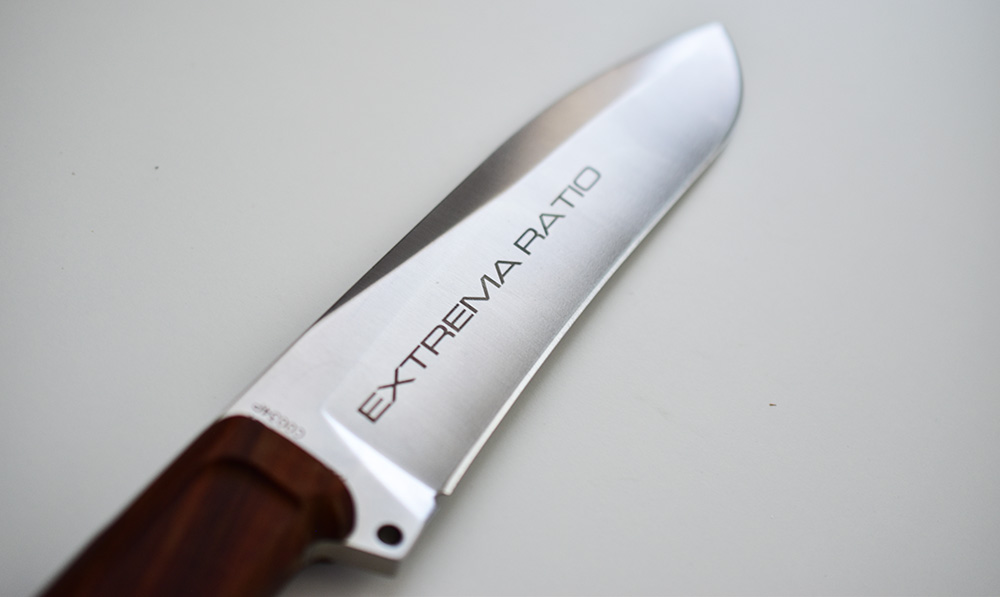
N690 Bohler steel is the perfect marriage between performance and edge retention. The N690 steel is also infused with Cobalt, giving the blade an extra edge, making it even sharper. The fusion of cobalt alloy also gives the blade extraordinarily high edge-retention. The edge also tends to be more even making it easy to resharpen and maintain.
The N690 Bohler steel is also known for its ability to resist corrosion from humidity, moisture, and salt. This makes the blade reliable under any climate or conditions.
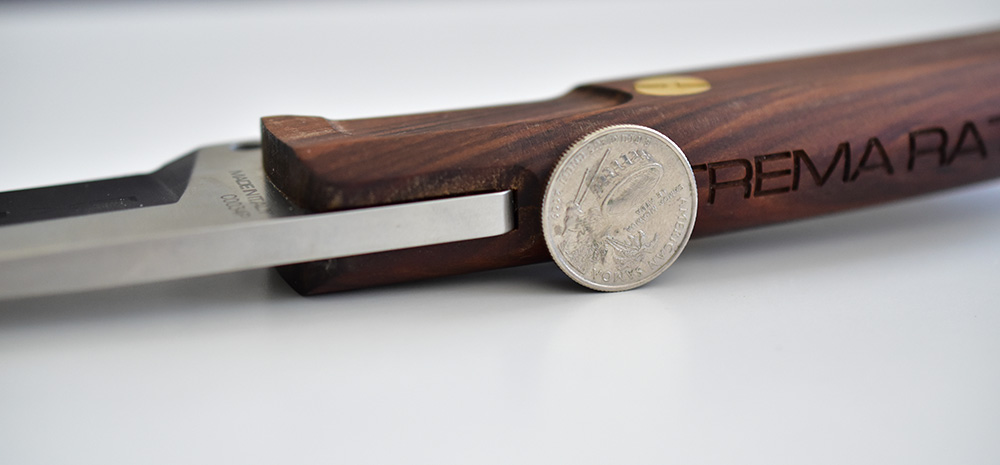
The blade is .25 inches thick, making it one of the thickest blades on the market. The extra thickness gives the blade rigidity and strength to handle anything you can throw at it. The picture above shows the blade with an American quarter next to it for scale. Despite having a thicker profile, the cutting edge is still razor-sharp.
HRC 58 Hardness
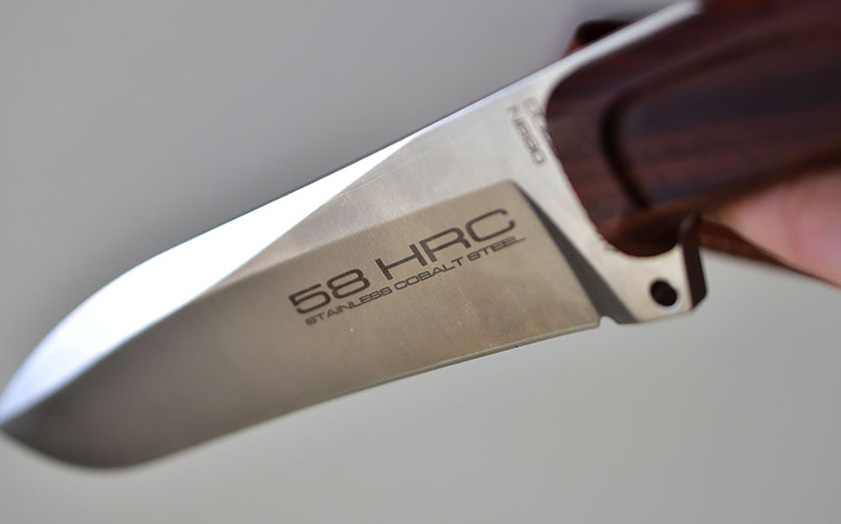
One perplexing question is why Extrema Ratio engraved “58 HRC” on the blade itself. For those who don’t know, HRC stands for Hardness Rockwell C. It’s a measurement of how hard the metal is. HRC 58 is hard, but certainly not the hardest metal in existence. For $600+, you would expect the metal to the of the highest grade.
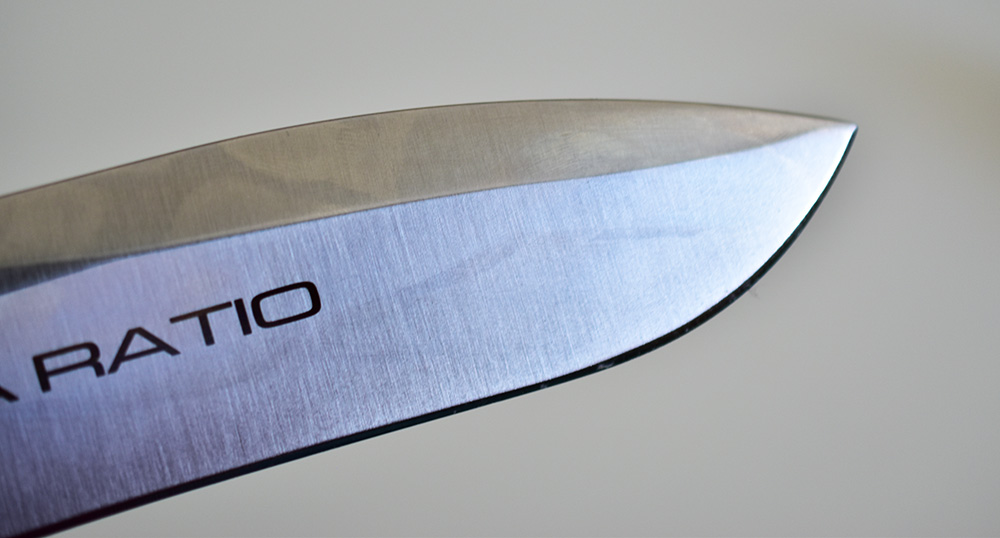
After researching this a bit further, it makes perfect sense why they chose this metal. The harder the metal and higher the HRC rating, the more difficult it is to sharpen. The Dobermann is meant to be a hunting knife and comes with its own sharpener. HRC 58 gives the blade all the strength it needs and also makes it easier to work with, sharpen, and maintain on the go.
Final Verdict
This knife will quickly replace every other knife you have and soon will be the only knife you carry around on hunting or camping trips. The N690 Bohler steel blade is sharp, sturdy, and wields a balanced mass that makes it easy to handle. It’s a heavy knife that can be tamed by the generously long handle. At 13.3 inches long with a 7.3-inch blade, there’s nothing this knife can’t handle.
Although the Dobermann is made for hunting, it’s just as good for close-quarter combat, chopping, skinning, and slicing. This knife will quickly become your go-to knife for just about everything. And the superior Italian craftsmanship will guarantee this will be passed down from generation to generation.
At $690, it’s not a cheap knife. But it’s well worth the price given its quality and useful it is. If you’re a hunter or someone who spends a lot of time in the wild, the Extrema Ratio Dobermann IV Africa is well worth the investment.
You may like
Business
Top Marketing Podcasts for 2025 You Should Be Following Today
Published
2 weeks agoon
October 17, 2025By
Skylar Lee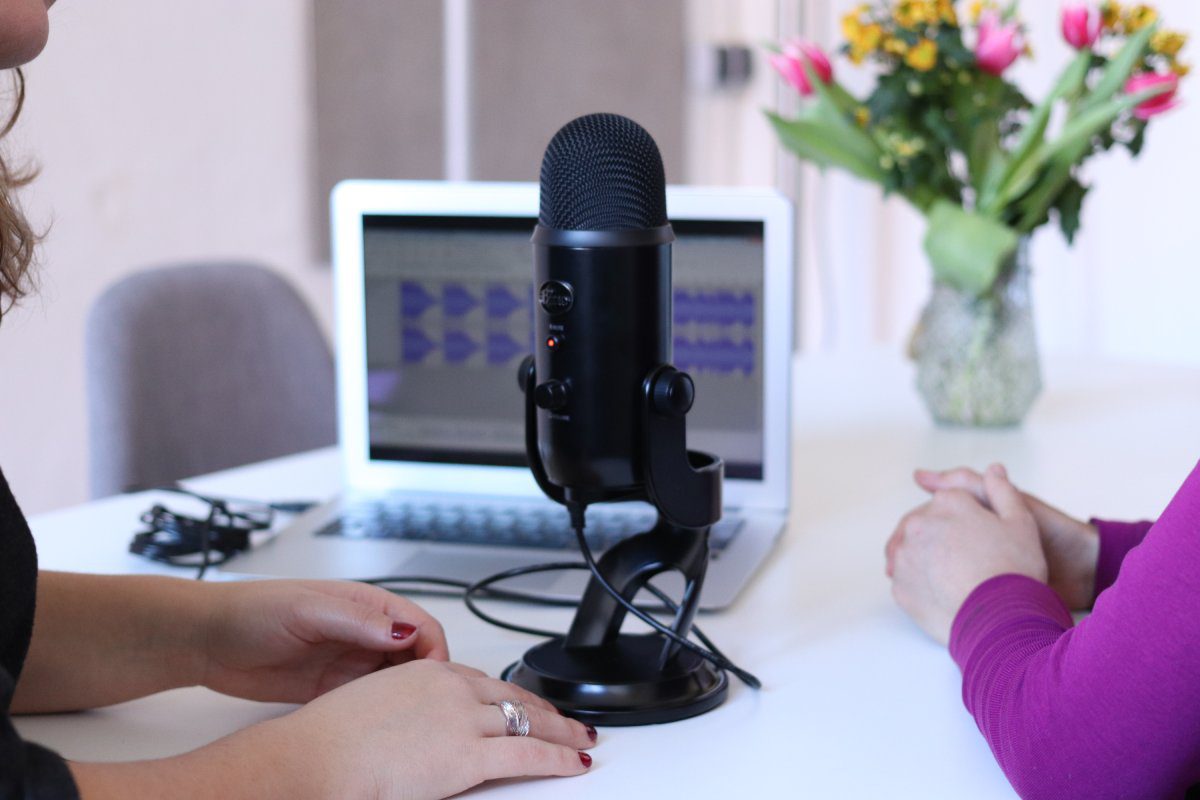
Being a marketer means constantly being on the lookout for the latest in marketing trends and news. You’ll be surprised how fast trends come and go, along with the tools that you commonly use for your campaigns. If you’re looking for a trend that never goes out of style, it’s podcasting. Here are the top marketing podcasts to tune in to in 2025:
1. Marketing School

Marketing School is hosted by one of the famous names in the marketing industry: Neil Patel. Eric Siu is also another popular figure hosting the show. They update listeners on the newest marketing and SEO trends and information. Plus, they interview content creators and marketers to share their marketing secrets and tips to achieve their goals. It’s a great starter podcast for new marketers in the field. Listen to the famous hosts every day!
2. Social Media Marketing Podcast

The Social Media Marketing Podcast should be your go-to podcast if you’re focused on social media marketing. Listen to Michael Stelzner weekly to get the best tips on marketing on social media with the latest tech and trends. If you’re also running out of content ideas, the podcast host also provides tips and insights to help you get started on new strategies. Plus, he interviews marketers and business leaders on how they achieved success with social media marketing.
3. The WARC Podcast

The WARC Podcast delivers marketing insights to help you know the latest in marketing for the week. You’ll learn what marketing challenges marketers overcame. Listen to them twice a week for recent trends, interviews, and event recaps.
4. Duct Tape Marketing

Another big name in the marketing sphere is Duct Tape Marketing, which made an impact in 2005. Listen to John Janstch three times a week to listen to interviews with small business owners and marketers, and how they grew their businesses through marketing strategies. Don’t miss out on the trends and tips to supercharge your marketing.
5. Perpetual Traffic

If you want tips from expert marketers Ralph Burns and Kasim Aslam, listen to Perpetual Traffic! They specialize in paid traffic tips to help you increase sales and leads! Expect interviews from various experts in different niches. You can also get insights from case studies to help you grow your business. Listen to them twice a week!
6. The Digital Marketing Podcast
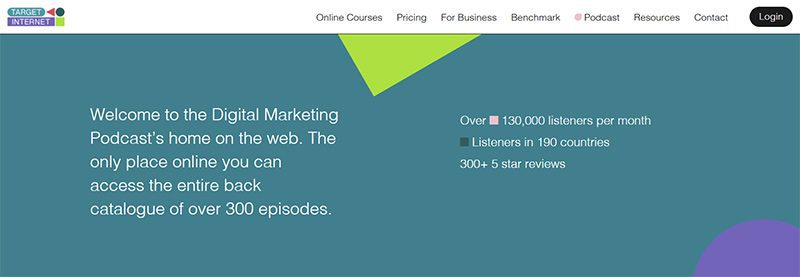
Do you want to be updated on everything digital marketing? The Digital Marketing Podcast is the best podcast to listen to. Know the latest news, updates, stats, and future of marketing. The hosts also discuss current tech trends in marketing to grow your business. Listen to the hosts twice a week!
7. The Affiliate Guy

Are you an affiliate marketer and need expert advice and the latest updates on affiliate marketing? You should listen to The Affiliate Guy. Hosted by Matt McWilliams, he has trained over 320,000 affiliates.
Think of The Affiliate Guy’s podcasts as engaging audio versions of How-To blogs. Additionally, he interviews entrepreneurs and leaders. Plus, he also references case studies to help you understand how they achieved their goals.
8. Marketing Trends

The very apt Marketing Trends podcast updates you weekly with new information and insights about marketing! You can listen to CEOs, CMOs, and other thought leaders share best practices and strategies to grow the biggest brands! Know how you can grow as a leader or an ambitious marketer when you get the latest tips for achieving success.
9. Stand The F*ck Out™

Are you tired of hearing or reading the same marketing tip or trend and don’t want to use that strategy anymore? Stand The F*ck Out™ gets straight to the point and doesn’t dilly dally when discussing marketing. Louis Grenier hosts the show and provides evergreen topics. You also get to hear from experienced marketers how their teams executed strategies and got the desired results. Listen to this podcast weekly.
10. Social Pros Podcast

Are you interested in learning how social media marketers execute their campaigns for big brands? The Social Pros Podcast should be on your radar. Jay and Adam host the show, which you can listen to weekly. Not only do they discuss recent trends and strategies, but they also discuss team management and other personal conversations on being a marketer.
11. Marketing Over Coffee

Do you prefer listening to podcasts in the morning during breakfast? Why not listen to Marketing Over Coffee on the side while enjoying a hearty morning meal? Like other podcasts, you’ll hear the latest tech trends like AI and improved marketing tools. Plus, get insights from the experts like Seth Godin, Rand Fishkin, and Ann Handley! Episodes come out weekly!
Lifestyle
What the Hell Was Magic Dirt? The Black Oxygen Organics Hoax
Published
2 months agoon
September 11, 2025
It has been years since we experienced the bizarre that was the pandemic, and yet, shady schemes still abound in the form of MLM (multilevel marketing) related to it. If you’ve ever heard or seen Magic Dirt, you’re not alone in wondering what it is all about.
While we’re now in the era of AI breakthroughs, space tourism, and wearable brain tech, some people still seem to be stuck in the horrid past. Sellers are peddling literal dirt as a miracle health product. Promoted mainly by anti-vax influencers and conspiracy circles, this dirt they call “wellness solution” was sold with pseudoscience, fear tactics, and a generous dose of misinformation.
And yes, it was an MLM. Because of course it was.
Here’s the breakdown of the Magic Dirt controversy—just one of many reasons why multi-level marketing schemes continue to be a red flag for anyone with a functioning sense of skepticism.
Planting The Seeds
It all began in May of 2021 when we were finally getting into the rhythm of our “new normal.” Of course, health was a significant topic of discussion in the media. It’s no surprise that many alternative medicines are gaining popularity on social media. It was during this month that a peculiar brand emerged on the scene. Depictions began circulating with smiling women slathering black mud on their faces, drinking jars of black liquid, and placing their babies’ feet in a tub of black water.
In the captions, they listed the numerous benefits of using this new “magic dirt.” And of course, the benefits varied from person to person. You might read one post that credits the dirt with curing her child’s low energy and constipation. Then you might scroll on to read another post claiming that it rejuvenates the skin while calming anxiety.
One thing these posts had in common was that they contained the hashtag #BOO while providing a shoutout to the company Black Oxygen Organics.
So, what does Black Oxgen Organics have to say about their “magic dirt”? As a brand, they described their product as,
“the end product and smallest particle of the decomposition of ancient, organic matter.”
Yeah, it’s purposely vague. In short, Magic Dirt is supposed to be a form of fulvic acid. This is a compound derived from the decayed plants of an Ontario peat bog. Sounds super rejuvenating, right?
To be fair, fulvic acid is shown to help with allergies and gastrointestinal function. But as with your average MLM, Black Magic Organics has exaggerated these benefits to the tenth power. They’ve taken these benefits and used them to sell 4.5 ounces of literal dirt, sealed in a fancy black bag and stamped with a $110 price tag. And if that didn’t feel like a slap in the face already, this stuff didn’t even come with free shipping!
Magic Dirt is claimed to be safe for anyone of any age. This includes your children and your pets. It’s been said to help heart health, brain function, and pretty much every common health problem in the world.
Of course, with it being 2021 and all, it started getting sent around to anti-vax and COVID-sceptical groups. Instead of seeking treatment for a deadly virus, people were mixing mud into their smoothies and calling it a day.
The Immediate Downfall
As Instagrammers and TikTokers promoted this “cure-all” product, an alarming number of women were eager to become direct sellers. For many, this company was their first introduction to the notorious Multi-Level-Marketing schemes.
That is, until the professionals got involved. You see, Magic Dirt was not at all FDA approved. And when health regulators from the U.S. and Canada became aware of its popularity, they conducted an investigation. They called for multiple product holds at the border, which in turn gave rise to an army of online skeptics.
And in typical MLM fashion, Black Oxygen Organics took their money and ran for the hills. Only about six months after its initial success, the company announced that it was officially shutting down. This sparked a significant backlash from online sellers. They grieved the end of miracle supplements, while also petitioning to recover the thousands they had invested in direct selling.
Unfortunately, most victims of these schemes will likely never recover their money.
The fact of the matter is that Black Oxygen Organics and similar companies are based on a scam. Period. That’s what everyone needs to remember, so they can avoid making the same mistakes as so many others. Always be vigilant for predatory companies.
Lifestyle
These Anti-MLM Communities Are Saving People from Scams
Published
3 months agoon
July 31, 2025
Have you ever stumbled upon an MLM online community? If your answer is no, you’re lucky. But if you did, you’d know that they can be a breeding ground for toxicity. Fortunately for some, a new wave of anti-MLM communities has emerged and is giving the much-needed breath of fresh air.
These communities include people who use their platforms to warn us about these dangerous schemes. They also provide a support system for those who are still enmeshed in it and trying to find a way out.
If you’re one of the unlucky ones trying to escape or are just curious, check out these four anti-MLM communities that are saving people from scams.
r/antiMLM

I just love Reddit. It provides a window into just about any subculture, no matter how obscure, and connects you with like-minded people from around the globe. It’s honestly the easiest place to find communities with shared interests.
r/antiMLM is just one of the many communities Reddit has to offer. People will post discussions, pictures, and screenshots showcasing the horror of MLMs. The content ranges from lighthearted and funny, to downright sad. Either way, everyone here has the same idea: MLMs are harmful and predatory. Should anyone come across this subreddit, they’ll be way less likely to fall for a pyramid scheme. And by subscribing to said subreddit, they are nearly eliminating all possibilities of going anywhere near an MLM. Subscribers of r/antiMLM are familiar with popular MLM companies, their tactics, and the red flags within the direct marketing industry. They are quicker to identify this type of scam.
The Anti-MLM Coalition

This website is an absolute GODSEND. The Anti-MLM Coalition is an incredible organization filled with educational materials and various resources. You can tell from the homepage alone that they mean business.
The menu bar provides 8 main website pages. The “Homepage “is filled with their latest articles and a search bar to navigate. “MLM Master List” is exactly what it sounds like: a list of all the known MLM companies in existence. The “MLM or Not?” page brings users to a long article detailing how to spot your typical pyramid scheme.
“Get Help” is a page filled with helpful information. It’s for people who have a loved one trapped in an MLM, or people who wanna take action against these companies. Each link leads to a detailed article on the subject.
The “Resources” page is a shoutout to various authors, YouTubers, and documentaries. It helps anyone who’s trying to do further research. They have a page dedicated to a very shareable infographic; a great tactic to spread the word around fast.
The “Activism” page provides a guideline on where and how to take action. They recommend printing cards, reporting, and exposing MLM corporations on social media. The more buzz, the better.
And of course, they have a “Contact” page in case you need to get in touch.
MLM Lies Exposed

Looking for more places to discuss your anti-MLM sentiments? Or just looking for general help without the hassle? Well, here’s the biggest anti-MLM Facebook group. MLM Lies Exposed is an invite-only community with over 30,000 members. It’s a lot like r/antiMLM, in that you can post things involving the false promises and skeevy behavior behind MLMs. I’d recommend this page to anyone who’s more familiar with Facebook or finds it easier to navigate than Reddit.
Anti- MLM Youtube

Now, hear me out. This is not an official community, but if you’re a regular on YouTube, you’ll know that there are different genres of videos. And each of these genres has garnered its own distinct communities.
They’re kinda like cliques. You’ve got gamer bro YouTubers at one table, and you’ve got beauty influencers at another table. You’ve got commentary YouTubers sitting somewhere near the true crime YouTubers and the podcast channels. Somewhere in the corner, you’ve got the anti-MLM spaces. These YouTubers dedicate their channels to spreading awareness about MLMs and other shady corporate behavior.
Popular YouTube channels include Hannah Alonzo, iilluminaughtii, NOT THE GOOD GIRL, and Kiki Chanel
MLM companies often pretend to be a revolutionary force changing the world and their own lives. In truth, they’re just making their distributors continue a cycle of unhappiness and financial ruin. These are the communities that help people who’ve been duped by these false hopes to move on with their lives.

What’s the Best No Limit Creatives Alternatives?

What’s the Best Graphic Design Service for Startups

What’s the Best Graphic Design Service for Ecommerce Businesses?

What’s the Best Fiverr Alternatives?

What’s the Best Superside Alternatives today?

What are the Best Canva Alternatives for Designers and Marketers?
What’s the Best Design Pickle Alternative?

What are the Best Canva Alternatives for Designers and Marketers?

What’s the Best Superside Alternatives today?

What’s the Best Fiverr Alternatives?

What’s the Best Graphic Design Service for Startups

What’s the Best Graphic Design Service for Ecommerce Businesses?




